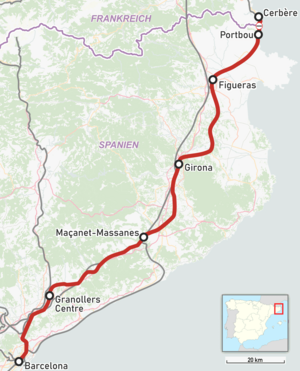Barcelona – Cerbère railway line
| Barcelona – Cerbère | |||||||||||||||||||||||||||||||||||||||||||||||||||||||||||||||||||||||||||||||||||||||||||||||||||||||||||||||||||||||||||||||||||||||||||||||||||||||||||||||||||||||||||||||||||||||||||||||||||||||||||||||||||||||||||||||||||||||||||||||||||||||||
|---|---|---|---|---|---|---|---|---|---|---|---|---|---|---|---|---|---|---|---|---|---|---|---|---|---|---|---|---|---|---|---|---|---|---|---|---|---|---|---|---|---|---|---|---|---|---|---|---|---|---|---|---|---|---|---|---|---|---|---|---|---|---|---|---|---|---|---|---|---|---|---|---|---|---|---|---|---|---|---|---|---|---|---|---|---|---|---|---|---|---|---|---|---|---|---|---|---|---|---|---|---|---|---|---|---|---|---|---|---|---|---|---|---|---|---|---|---|---|---|---|---|---|---|---|---|---|---|---|---|---|---|---|---|---|---|---|---|---|---|---|---|---|---|---|---|---|---|---|---|---|---|---|---|---|---|---|---|---|---|---|---|---|---|---|---|---|---|---|---|---|---|---|---|---|---|---|---|---|---|---|---|---|---|---|---|---|---|---|---|---|---|---|---|---|---|---|---|---|---|---|---|---|---|---|---|---|---|---|---|---|---|---|---|---|---|---|---|---|---|---|---|---|---|---|---|---|---|---|---|---|---|---|---|---|---|---|---|---|---|---|---|---|---|---|---|---|---|---|---|
|
Spanish multiple unit in the French border station Cerbère.
| |||||||||||||||||||||||||||||||||||||||||||||||||||||||||||||||||||||||||||||||||||||||||||||||||||||||||||||||||||||||||||||||||||||||||||||||||||||||||||||||||||||||||||||||||||||||||||||||||||||||||||||||||||||||||||||||||||||||||||||||||||||||||
| Route number : | 270 | ||||||||||||||||||||||||||||||||||||||||||||||||||||||||||||||||||||||||||||||||||||||||||||||||||||||||||||||||||||||||||||||||||||||||||||||||||||||||||||||||||||||||||||||||||||||||||||||||||||||||||||||||||||||||||||||||||||||||||||||||||||||||
| Route length: | 162 km | ||||||||||||||||||||||||||||||||||||||||||||||||||||||||||||||||||||||||||||||||||||||||||||||||||||||||||||||||||||||||||||||||||||||||||||||||||||||||||||||||||||||||||||||||||||||||||||||||||||||||||||||||||||||||||||||||||||||||||||||||||||||||
| Gauge : | 1668 mm ( Iberian track ) | ||||||||||||||||||||||||||||||||||||||||||||||||||||||||||||||||||||||||||||||||||||||||||||||||||||||||||||||||||||||||||||||||||||||||||||||||||||||||||||||||||||||||||||||||||||||||||||||||||||||||||||||||||||||||||||||||||||||||||||||||||||||||
| Power system : | 3000 V = | ||||||||||||||||||||||||||||||||||||||||||||||||||||||||||||||||||||||||||||||||||||||||||||||||||||||||||||||||||||||||||||||||||||||||||||||||||||||||||||||||||||||||||||||||||||||||||||||||||||||||||||||||||||||||||||||||||||||||||||||||||||||||
| Top speed: | 160 km / h | ||||||||||||||||||||||||||||||||||||||||||||||||||||||||||||||||||||||||||||||||||||||||||||||||||||||||||||||||||||||||||||||||||||||||||||||||||||||||||||||||||||||||||||||||||||||||||||||||||||||||||||||||||||||||||||||||||||||||||||||||||||||||
| Train control : | ASFA , ETCS Level 1 | ||||||||||||||||||||||||||||||||||||||||||||||||||||||||||||||||||||||||||||||||||||||||||||||||||||||||||||||||||||||||||||||||||||||||||||||||||||||||||||||||||||||||||||||||||||||||||||||||||||||||||||||||||||||||||||||||||||||||||||||||||||||||
| Dual track : | Barcelona – Portbou | ||||||||||||||||||||||||||||||||||||||||||||||||||||||||||||||||||||||||||||||||||||||||||||||||||||||||||||||||||||||||||||||||||||||||||||||||||||||||||||||||||||||||||||||||||||||||||||||||||||||||||||||||||||||||||||||||||||||||||||||||||||||||
| Further gauge: | 1435 mm ( standard gauge ) | ||||||||||||||||||||||||||||||||||||||||||||||||||||||||||||||||||||||||||||||||||||||||||||||||||||||||||||||||||||||||||||||||||||||||||||||||||||||||||||||||||||||||||||||||||||||||||||||||||||||||||||||||||||||||||||||||||||||||||||||||||||||||
|
|||||||||||||||||||||||||||||||||||||||||||||||||||||||||||||||||||||||||||||||||||||||||||||||||||||||||||||||||||||||||||||||||||||||||||||||||||||||||||||||||||||||||||||||||||||||||||||||||||||||||||||||||||||||||||||||||||||||||||||||||||||||||
The Barcelona – Cerbère line is an electrified main line between the Catalan capital Barcelona in Spain and the southern French border station Cerbère in the Eastern Pyrenees . The double-track railway line is 162 km long and mostly runs through the hinterland of Catalonia. Until the high-speed line Madrid – Figueres went into operation , the railway line was considered to be one of the most important north-south connections in Europe.
history
| Opening date | Route section |
|---|---|
| July 22, 1854 | Barcelona – Granollers |
| September 1, 1860 | Granollers-Rambla Santa Coloma |
| March 3, 1862 | Rambla Santa Coloma – Girona |
| October 28, 1877 | Girona-Figueres |
| January 20, 1878 | Figueres-Cerbère |
After the first railway line in Spain between Barcelona and Mataró was opened in 1848 , construction work began shortly afterwards for a hinterland connection towards the French border. In 1854 the first partial commissioning took place after Granollers , in further stages the French border town of Cerbère was finally reached in early 1878 , where a connection to the also newly built railway line from Narbonne was established. The Balitres tunnel, in which the national border runs, was built between the border stations at Portbou (on the Spanish side) and Cerbère . Due to the different gauges in Spain and France, one track in Iberian broad gauge and one in standard gauge was built in the double-track tunnel . In Port Bou and Cerbère extensive track systems were built to a. to enable the reloading of goods onto the freight cars of the other railway.
Shortly after its continuous opening, the new connection gained great importance in European rail traffic. Numerous day and night train connections between northern and southern Europe were created. Further attractive connections were created at the end of the 1960s through the use of automatically rerouted Talgo passenger trains.
On the Spanish side, the railway line was electrified in 1963 to Portbou and in 1964 to Cerbère. In France, electrification did not take place until the beginning of 1982.
With the construction of the high-speed line Madrid – Figueres in December 2013, the importance of the line for both passenger and freight traffic has decreased significantly. Long-distance passenger transport no longer takes place.
service
Both regional and regional express trains (Media distancia) run between Barcelona and Cerbère . The suburban train line R2 Nord of the Rodalies de Catalunya also runs between Barcelona and Maçanet-Massanes . Coming from Perpignan, several SNCF TER trains end in Portbou, Spain, during the day.
The cross-border regional trains have ended so far, behind the state border in Portbou or Cerbère and then returned to their national territory as empty journeys. The same situation can still be found today in the border section of the Bordeaux – Irun railway line . Since February 2019, the previous empty journeys between the two countries have been released for passenger traffic.
photos
Remarks
- ↑ A mainline track between Girona and Villamalla is designed as a three-rail track in standard gauge (1435 mm) and Iberian broad gauge (1668 mm).
- ↑ A mainline track between Girona and Villamalla is designed as a three-rail track in standard gauge (1435 mm) and Iberian broad gauge (1668 mm).
- ↑ Common standard gauge (1435 mm) and Iberian broad gauge (1668 mm) route between Portbou and Cerbère.
- ↑ today: Maçanet-Massanes
Web links
- www.bueker.net - Track plan between Portbou and Cerbère (English)
Individual evidence
- ↑ Propuesta de tercer carril entre el puerto de Tarragona y el nudo de Castellbisbal. http://www.vialibre-ffe.com/ , accessed April 27, 2017 (Spanish).
- ↑ CRONOLOGÍA BÁSICA DEL FERROCARRIL ESPAÑOL DE VÍA ANCHA. (PDF) http://www.docutren.com/ , accessed April 27, 2017 (Spanish).
- ↑ La frontera de Port Bou, una historia ferroviaria. http://www.vialibre-ffe.com/ , accessed April 27, 2017 (Spanish).
- ^ Railway lines in Catalonia. http://www.railway-history.de/ , accessed on April 27, 2017 .
- ↑ Cercanías de Cataluña conecta con Francia con trenes que enlazan con Cerbere. http://www.finanzas.com/ , accessed February 13, 2019 (Spanish).





